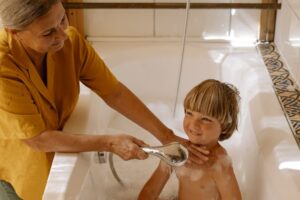Is a time-out from time itself—a suspended moment when both Mummy and Daddy and baby are naked, soaked, soapy, and scrubbed together.
Bathtime has the potential to be a moment of mutual giggling, bonding, storytelling, frolicking, splashing, dipping, getting clean, getting squishy, making faces, smoothing lotion, and bedtime prep.
Ideally, bath time can be one of those gold daily stars when running a household. It can be done playfully, with lots of laughter and fun. If you’re lucky, a bath can be a defining memory of every day.

But let’s face it: it hasn’t always been that way. For foggy-brained survivalist parents who might feel a little frayed around the edges from a day of rocking bubs to sleep, bath time – at least initially – can feel more like a hurdle to cross than a pleasure to proffer. ‘No, stop splashing your sister with that glass of water!’ ‘Sit down.
Yes, sit down.’ ‘Put some clothes on, we’re going out.’ And then: ‘OK, kids, bath time!’ Can there be anything that parents dread more than bathing their offspring? Nothing robs a parent of life’s joy more than bath time.
Nothing is more fun than a long, clean soak in the bathtub, preferably complete with a bubble bath and a giant rubber duck, maybe even a bath sponge with eyes and a smiley face on one side and a ducky nose and ears on the reverse.
So why does it always seem to be the exact opposite for those in charge of little ones? ‘Did you pee in the tub?! Oh, what’s that – you need a potty now… fine, let’s go!’ To set it up and then be on a mission to keep every splash, slip, crash, and bang away.
From the part of your home where other appliances – such as your laptop, your phone, your good clothes, or your everyday reading glasses – are all within reach (and therefore within danger) is the quintessence of parenting.
The smart ones house-train their kids far ahead of the typical baby health booth giveaway of about nine months old.
1. Set the Scene: Bath Safety First
Oh, okay. If we have to ruin the fun with pedestrian matters such as safety, here goes. To keep your kiddie safe in those bubbles and giggles, never forget these all-important top extra-safety tips on how to bathe your baby: 1) Always use your right foot to open the battery compartment of the baby bath.
a.Temperature Check: Bath water should be warm but not hot, around 37-38°C (98-100°F). It’s always best to test the temperature with your wrist or a bath thermometer before your child gets in. The American Academy of Pediatrics recommends setting a water heater to 120°F to prevent injury from scalding.
b.Constant Supervision
Never leave a child alone in the tub, no matter how briefly. Don’t wait till there’s water blindingly covering your child’s head. Don’t wait till the tub is brimming, and there’s virtually nowhere for your tot to go but down.
Drowning can happen instantaneously, even in water covering a small body part. Just by keeping your eyes on them, you’ll ensure their safety and also be able to play along.
c.Preventing Slips and Falls
Add non-slip mats inside and outside the tub to prevent slipping. Also, just to be safe, Cover the faucet with a soft faucet cover in case they bump around.
d.Using Child-Friendly Products
Use gentle, hypoallergenic, child-friendly soaps and shampoos that won’t sting the eyes and don’t contain harsh chemicals. Washing with these products makes bath time more pleasant, not to mention less painful.
These safety basics will get your simple bathing routine started right!
2. Bring on the Fun: Toys and Games
When safety is taken care of, let the fun begin! While bath toys are perfect for keeping kids distracted, they can also be a tacky educational tool for developing motor skills and sensory exploration. Here are some toys to stay playful and developmental fun:
a.Classic Rubber Ducks and Floating Toys
These are bathtime staples for a reason! Floating toys add color and fun to the water and can even be used for pretend play while they float around. Bath squirters, floating animals, and boats add additional play opportunities and can be used to practice coordination skills.
b.Pouring Cups and Water Wheels
Stackable cups, funnels, and water wheels lend themselves to pouring, filling, and emptying, improving hand-eye coordination and introducing cause and effect. [The online journal Parenting Science](https://www.parentingscience.com/) notes how simple water play can stimulate a young child’s cognitive development.
c.Bath Crayons and Foam Letters
– Let kids scribble away with bath crayons – a tub-only marker – or stick foam letters to the tubside and experiment with writing, drawing faces, or making scenes underwater, a canvas for the body-cleaning process.
d.Light-Up Toys and Musical Bath Accessories
have a flash of light with waterproof LED bath toys or musical accessories. Add wonder with light-up toys and beat with musical instruments; make sure these toys have a proper waterproof seal and are battery-sealed, so babies don’t have access to the battery casing.
3. Incorporate Learning Activities
Bath time also allows you to learn a little—as long as you do it correctly. The right way makes the tub a classroom as educational as fun.
a.Counting and Sorting
Try counting with small toys or when filling small cups with water. For example, ‘How many ducks are in the tub?’ or ‘Put all the blue toys in a group!’
b.Introduce Science Concepts
Bath time is a great place for a buoyancy and volume lesson. Talk about what floats and what sinks. Why do some objects hold water, and why don’t others? A plastic cup, a sponge, and a rock are things from around the house that can be fun to play with.
c.Storytime and Imaginative Play
Make bath time an ocean voyage (or a kingdom in the clouds): the tub is the ocean, and the rubber ducks are explorers, or vice versa \[ photo by Gregoire mattress on Unsplash \] Children can go on underwater expeditions while practicing spelling words, kings and princesses can retreat into hiding if said aloud (or shared by text message), dogs sneak into elementary school classes wearing coats, nurses get fired, frogs become teachers.
Story-cum-play can be especially beneficial in expanding vocabulary and imagination. The [Child Development Institute](https://childdevelopmentinfo.com/) notes that pretend play is a wonderful way to boost social and cognitive growth.
4. Make it a Sensory Experience
Bath time can also help with calming sensory experiences for your child. Differing the textures that they experience through water, shampoo/soaps, or lotions, different odors can be introduced, as well as auditory ones with toys that squirt water, squeak, or even encapsulate fun sounds if held to the ear.
These diverse sensory experiences will help the child feel calm, engaged, and in the right headspace for going to bed.
a.Add Calming Scents
Add a couple of drops of essential oils that are safe for babies and for calming down, like lavender or chamomile. Use only baby-safe essential oils and not too much of them, as children’s skin is extra sensitive.
b.Play with Bubbles and Foam
A bit of gentle bubble bath also goes a long way. Letting kids watch and then pop bubbles is a simple game that ensures they’ll be occupied and can be a hit in the bath. If your little one likes foam, you can buy special foam bath soaps so they can ‘sculpt and play.’
c.Add Different Textures
Tiny sponges, soft washcloths, or even just some specialized homemade scrubbers can bring new and delightful sensations, enriching play with textures and helping to foster at least some form of sensory awareness and exposure to sensations, albeit in a playful context.
5. Wind Down with a Routine
Making bath time a daily routine helps children relax before bedtime. A stable, predictable pattern makes young children feel sure of themselves.
a.Start with a Timer or Signal
Ring a bell or set a timer to signal bath time. This creates a pivot from one activity (‘I’m playing with the blocks!’) to another (‘Time for a bath now’), allowing your child to shift and decreasing resistance mentally.
b.Incorporate Soft Music or Lullabies
Pamper them with a soothing bath set to gentle music (or a favorite lullaby, though that is more work); ambient lighting and bath bubbles or toys can also feel relaxing for everyone.
Keep them up as late as you can as the evening slowly winds down. This is the day’s penultimate hurdle.
c.Have a Post-Bath Routine
Lotion, a towel wrap after a bath, and a goodnight story. A snuggly end to the bath makes the transition from playtime to tuck-in time easier, plus associates bathing with coziness.
6. Encourage Independence and Confidence
Giving children a bit of responsibility for bath time can make them feel more independent and confident. For younger children, here are some incremental ways for them to be in charge of bath time:
a.Teach Simple Bath Tasks
Let them pour water to rinse or even hold the washcloth to clean their arms and legs. This will teach them independence and give them a good practical lesson in hygiene.
b.Let Them Choose Bath Toys
for example, ‘You can pick which bath toy you want today,’ or ‘Tell me which scent of bubbles you like best.’ These little touches grant children a sense of choice and, thereby, a degree of ownership, which helps to make bath time feel like ‘my’ bath rather than ‘the’ bath.
c.Celebrate Achievements
Praise them for trying out a new bath activity on their own. Acknowledging those tiny triumphs can bolster confidence and anticipation about the next bath.
Conclusion: Make Every Splash Count
It doesn’t have to be a daily battle over the bathtub. With a few thoughtful changes, bath time can become one of the most anticipated parts of your child’s day, an opportunity to teach safety, explore science, and foster (or finish) a long day, all while having fun.
And isn’t the tub where you make lasting memories – fun, splashes, and all that – the kind you want to keep? Whether you’re raising your own universe of bubbles, getting your child out of her scientific phase, or just being eager to see the little one tucked into bed at last, remember that you can do all this – and more – just by focusing on safety and fun.
Enjoy it while it lasts. You won’t be mopping up these messes once your child flits away into middle school or beyond.
Check out more expert advice regarding child safety and development at [HealthyChildren.org](https://www.healthychildren.org/) and [Parenting Science](https://www.parentingscience.com/).
So, with these, bath time becomes not only safe but fun and imaginative…and this time, yours.
